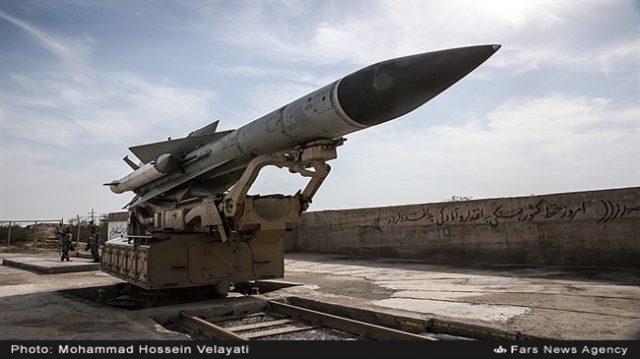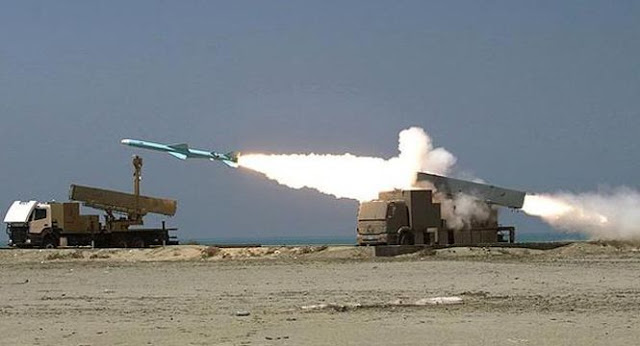 The relatively large number of airstrikes in Syria that have recently been attributed to the Israel Air Force and the escalating Syrian response to these attacks are part of what can be described as a battle over the next war.
The relatively large number of airstrikes in Syria that have recently been attributed to the Israel Air Force and the escalating Syrian response to these attacks are part of what can be described as a battle over the next war.
Iran and Hezbollah have initiated this battle in an effort to turn Syrian into another front against Israel if a war breaks out between either of them and the Jewish state.
Hezbollah and the Lebanese are afraid that in the next war, Israel will quite literally demolish Lebanon in its fight against the terror organization’s strongholds and rocket launching sites in southern Lebanon.
Will you offer us a hand? Every gift, regardless of size, fuels our future.
Your critical contribution enables us to maintain our independence from shareholders or wealthy owners, allowing us to keep up reporting without bias. It means we can continue to make Jewish Business News available to everyone.
You can support us for as little as $1 via PayPal at office@jewishbusinessnews.com.
Thank you.
Hezbollah and the Iranians have more or less exhausted the potential in turning Lebanon into their base of operations against the Israeli home front and its northern communities. That is why they need a new front from which they could also launch rockets, missiles and drones towards Central Israel, while at the same time launch terror attacks on the ground against border-adjacent Israeli communities in the north.
This is what they want to establish in the Golan Heights. In early 2015, Iran and Hezbollah already mounted a major attempt to establish this front in the Syrian Golan, but that attempt was foiled when—according to foreign reports—Israeli aircraft attacked a convoy transporting the commanders of that front, including Jihad Mughniyeh, an Iranian brigadier general and commanders in the Syrian army.
After that assassination, the efforts to turn the Golan Heights into another front against Israel have died down. But now an additional, slightly different attempt is underway, starting on the tail end of 2016. This time, the idea is not just to use the front line in the Golan Heights as a base from which attacks and rockets can be launched, but rather turn the all of Syria into a new base of operations for Hezbollah and Iran.
A possible reason for this renewed effort is the increasing difficulties Iran is facing in its efforts to transfer quality, strategic weapons to Hezbollah in Lebanon through Syria. It is possible the Iranians and Hezbollah realized their efforts were rather transparent as reports point to attacks against many of the arms shipments.
But what’s more important is that Lebanon does not have an anti-aircraft apparatus that could protect Hezbollah’s rockets and missiles.
Meanwhile, Syria has everything Hezbollah needs: Starting with factories in northern Syria where rockets and missiles are being manufactured for the Shi’ite militia, through launch sites scattered all over the country—which is also far larger than Lebanon—to Assad’s anti-aircraft apparatus.
Syria’s air defense apparatus has hardly been damaged in the civil war, and it is capable of providing Hezbollah and Iran with the protection they need should they decide to launch missiles from Syria at Israel, as well as protect facilities in Syria to manufacture and store the missiles for Hezbollah.
In other words, Iran and Hezbollah want to add another base of operations in which they would not only be protected by Syria’s anti-missile and anti-aircraft apparatus, but also by the Russian presence in the country. The Syrians believe Israel wouldn’t dare attack so close to Russian forces, despite Prime Minister Benjamin Netanyahu’s understandings with Putin not to hurt shared interests in Lebanon.
All this means that as long as Israel doesn’t try to undermine Assad’s regime and doesn’t aid the rebels—directly or indirectly—Russia will allow the IDF to have freedom of operations.
The Russian protection, which increased the Syria regime’s self-confidence, on the one hand, and the pressure from Hezbollah and Iran to start responding to Israel’s attacks on the other hand are what led the Assad regime to fire an anti-aircraft missile at Israeli jets.
Assad’s securities
Syrian President Bashar al-Assad is pretty sure that as long as the Russians are interested in the continuation of his rule, Israel would not dare cause him any real damage. That is why he allows Hezbollah and the Iranians to develop their base of operations in Syria. The Shi’ite array in Syria includes facilities to manufacture and store missiles and rockets, launch sites, and finally terror cells to carry out attacks and short-range shooting of rockets into Israel from the Syrian Golan.
As part of this base of operations, the Iranians asked Assad—and received—their own pier in the port of Latakia in northern Syria’s Alawite stronghold, through which they could transport raw materials as well as weapons manufactured by the Iranian military industry.
After his most recent meeting with Russian President Vladimir Putin, Prime Minister Benjamin Netanyahu told reporters that “We see Iran is trying to build a military force, with military infrastructure, in order to establish a base in Syria, including attempts by Iran to set up a sea port. All this has severe implications for Israel’s national security… I clarified to President Putin our vehement opposition to the establishment of Iran and its tentacles in Syria… I said this will be destabilizing and will harm the possibilities for the diplomatic arrangement that he intends to achieve.”
This new formation of an additional front in Syria that would serve the radical axis is dangerous and holds destructive potential to Israel.
The fact Hezbollah, Iran and Syria’s high trajectory weapons are dispersed across the territory of two countries—Lebanon and Syria—will make it harder for the IDF to deal with this challenge. It might even require action on two fronts at the same time. In addition, it would force Israel to allocate far greater forces to protect the communities in the Golan Heights than it currently has.
This is why the number of attacks in Syria attributed to Israel has increased. These attacks are meant to thwart Hezbollah’s plans to manufacture and store rockets and missiles in Syria and even launched from there, as well as to form local militias with the help of the Assad regime to carry our border-crossing attacks against Israel or fire into the Israeli Golan.
What happened over the weekend demonstrates that well. Early Friday, Israeli fighter jets attacked weapons manufactured in Syria—likely Scud-D missiles with a range of 700 kilometers—bound for Hezollah.
Everything is possible in this semi-covert war being waged between Israel and the radical Shi’ite axis led by Iran over Syria.
On Friday, the Russians joined the fray as well. They summoned the Israeli ambassador to Moscow to answer questions about the attack, probably because the strike occurred close to where Russian soldiers are stationed.
It’s possible that the Russians were angry over what they deemed as Israel endangering their troops, and it’s also possible that Assad demanded them to rebuke Israel for its alleged involvement in the attack, and the Russians decided to keep him happy. The Syrian president is now trying to thwart a large assault by the rebels on Damascus, and it appears the Russians are trying to curb Israel for him—at least for now. In any case, government officials in Jerusalem and military official at the Kirya base in Tel Aviv are sending messages that Israel has no intention to ease the pressure until Iran and Hezbollah abandon attempts to open a new front.
The strong Syrian respond to the airstrikes were meant to narrow and limit Israel’s area of operations, but the IDF was not impressed and operated—according to Moscow—even near areas where Russian troops have been deployed.
By Ynet News





